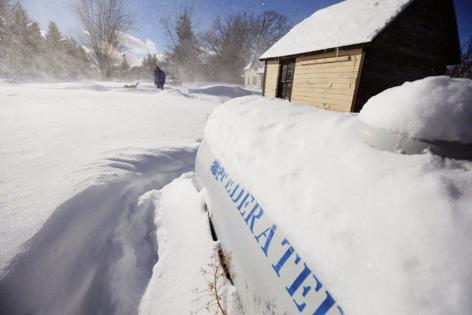Federal heating aid delays leave Minnesota propane users in especially 'precarious position'
Published in News & Features
MINNEAPOLIS — The federal shutdown is delaying critical funding that helps people in more than 125,000 households across the state pay their heating bills — and officials are warning the lag could be especially risky for rural Minnesotans who use propane and fuel oil.
As the shutdown nears its fourth week, payments for the Low Income Home Energy Assistance Program (LIHEAP) won’t go out without cash from the federal government.
Minnesotans who receive heat assistance are “kind of stuck in this limbo,” said Michael Schmitz, who oversees energy assistance programs at the Minnesota Department of Commerce, which administers the federal money.
The shutdown’s funding delays are likely to have substantial effects in Minnesota, where cold weather is setting in and some 300,000 people live in households relying on heat assistance.
Schmitz said he’s concerned because the state’s cold weather rule — which helps prevent residential utility shut-off in cold months — doesn’t extend to the state’s 270,000 households that use propane or fuel oil, a majority of which are in rural areas. Last year, LIHEAP funding helped pay for propane and fuel oil in more than 25,000 households in Minnesota.
“It’s those households that are reliant on delivered fuels that are probably in the most precarious position,” he said.
Annie Levenson-Falk, director at the Minnesota Citizens Utility Board, said energy burdens are typically higher in rural areas because there are, on average, lower incomes and higher energy costs. Prices for propane fluctuate more than natural gas or electric, Levenson-Falk said, and filling tanks is often a large expense at once — unlike monthly payments for gas or electric users.
“It might cost $800 or $900 to refill your tank,” she said.
Utility providers, including fuel delivery companies, are able to see if customers have applied for energy assistance, so they may be willing to create a payment plan or make a small delivery if a customer’s fuel tank is nearing empty. But that might be more difficult for smaller companies.
“Unlike regulated utilities, delivered fuel providers do not operate as monopolies and they lack captive ratepayers to share or offset operational expenses,” Dave Wager, director of the Minnesota Propane Association, said in a statement.
Even if the shutdown ends soon, funding for LIHEAP won’t arrive for at least a month after Congress approves a budget, according to Levenson-Falk.
“We’re all expecting energy assistance to be funded once Congress passes a bill that ends the shutdown,” she said. “So the money will come; it’s just going to be delayed, so I’m hopeful utilities will be flexible.”
Overall in Minnesota last year, the Commerce Department awarded more than $98 million in federal heating assistance to low-income households, with the average household benefit around $785. The money helped provide nearly 11,000 heating fuel deliveries, as well as prevent thousands of gas and electric disconnections, Schmitz said.
“Everyone can be impacted by [delayed funding] regardless of the heating fuel you’re using to heat your home,” he said. “Because even if you have cold weather rule protection, you might be falling behind on your bill, and those overages can add up over time.”
About two-thirds of LIHEAP funding is distributed to homes outside the Twin Cities metro. In St. Louis County in northwestern Minnesota, LIHEAP assistance helps pay for heat in about 8% of households. That’s more than double the percent of households served in Hennepin County.
Minnesota Power, a Duluth-based company that provides electricity to the Upper Midwest, has rate discounts and works with customers to create payment programs. Between 12%-14% of residential customers have past-due balances at any time, according to the company, averaging about $250.
Tina Koecher, the director of customer experience at Minnesota Power, said the company sees a 50%-75% increase in people needing payment plans during the months when cold weather protection is active. Customers have to call and ask to have a plan that is tailored to their circumstances, she said.
Schmitz said he’s cautiously optimistic about LIHEAP funding being included in the federal budget because it has bipartisan support in Congress. But he’s worried because the Trump administration has proposed eliminating the energy assistance program altogether.
“There’s lots of people all over the country who might go without heat if they don’t have a program like LIHEAP,” Schmitz said. “Or if they’re able to pay for heat, they might then go without food and they might go without their prescriptions or they might go without paying their rent.”
Although funding is delayed, agencies are frantically working to process applications in the interim.
“We’re really encouraging people to go ahead and get their application in so that when the funds become available, we’re ready to go,” said Lisa Drew of the Tri-County Action Program, the agency providing energy assistance programs for four counties in central Minnesota.
The shutdown is the second scare over LIHEAP funding this year, Schmitz said, referring to funding fears in April when the Trump administration laid off all the staff of the program that distributes LIHEAP funding. The administration released the money about a month later.
“It’s really hard to know how to plan, how to run a program in an environment of so much uncertainty,” Schmitz said.
©2025 The Minnesota Star Tribune. Visit at startribune.com. Distributed by Tribune Content Agency, LLC.







Comments